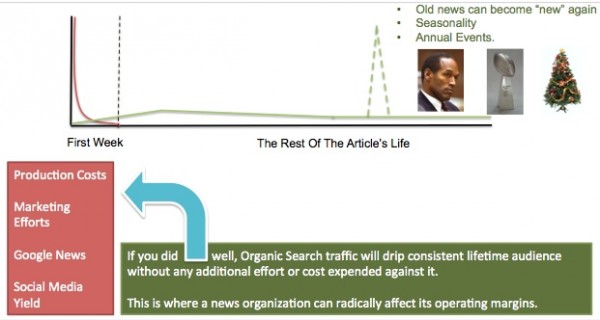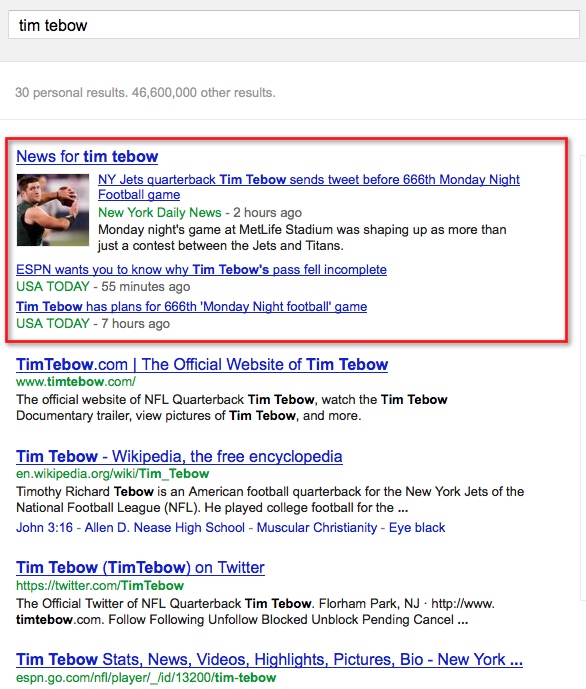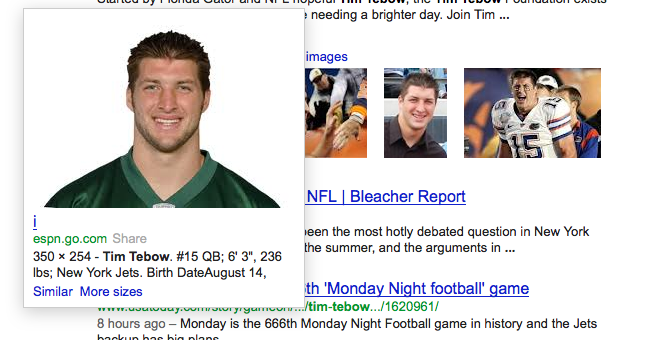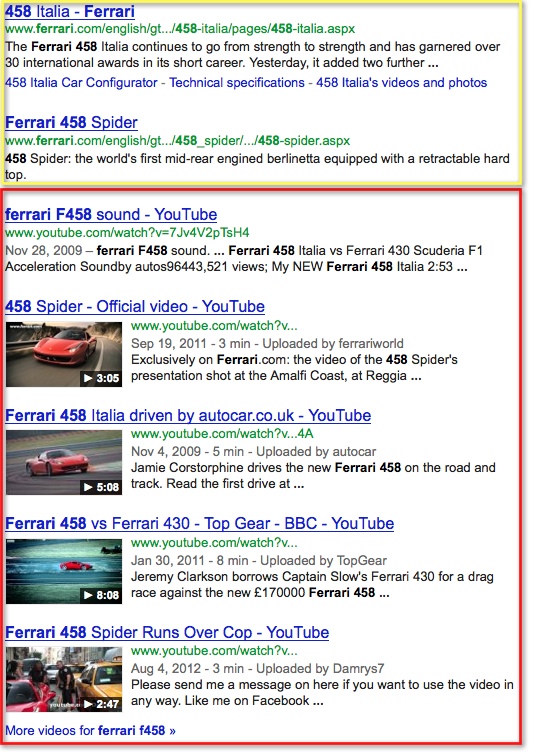The Publisher’s Guide To Enterprise News SEO
At Define Media Group, we jokingly say that we are unafraid to be the best in the world at an industry that is imploding faster than Amanda Bynes’s career. With many major media conglomerates as bedrock clients and hundreds of news and magazine titles under our watchful eye, the following thoughts represent our attempt at saving […]
At Define Media Group, we jokingly say that we are unafraid to be the best in the world at an industry that is imploding faster than Amanda Bynes’s career. With many major media conglomerates as bedrock clients and hundreds of news and magazine titles under our watchful eye, the following thoughts represent our attempt at saving you the blood, sweat, and Olympic-sized pool of tears those very same entities endured in News SEO.
Understanding The Life Cycle & Lifetime Economic Value Of Your News
There are two distinct News SEO periods: the first 48 hours and the lifetime archive value. Everything you do in the first 48 hours of a news cycle determines how you will be remembered for the next 100 years.
He (or she) who hustles the most gets the most Web citations, controls the narrative and will get the clicks when your grandchildrens’ grandchildren are searching for their class project.

News SEO Life Cycle and Lifetime Value
The latter point is where we usually get the CFO’s and COO’s attention. News is expensive to generate and, frankly, for most, it would be cheaper to light a bonfire of cash ablaze every Sunday.
But, for those entities that can build a News SEO competency, the ability to amortize those costs and monetize that traffic over a period that is essentially ad infinitum, the investment and margins start to make sense very quickly.
Google News Is Everything
Understanding that the first 48 hours when the news event is breaking is also when the vast majority of the backlinks and social mentions are generated, it is imperative to optimize your relationship with Google News.
Unlike Web Search, Google News is very much a relationship you can cultivate if you are a publisher of any relevance. They have their own charter and they are much more willing to work through technical issues with you. With a finely-honed Google News presence, you are in the game. Without it, I sincerely hope you have the world’s greatest social media or subscription apparatus at your disposal.
OK, So How Do I Kick Butt With Google News?
Keeping in mind that Google News and Google Web Search are two very different products, there are often challenges in succeeding at both. Most of these challenges can be overcome with a content management system (CMS) that allows for very simple things like independent Page Title and Article Headline fields (there are a painful number of old publishers where this is not the case).
While the current consensus is that the most heavily weighted on-page factor for Web Search is the Page Title, the Article Headline is front and center for Google News. This allows your editors to be more socially compelling for the native users and gives the Page Title field complete autonomy for the lifetime searchers coming from Web Search.
A Google News XML Sitemap is helpful if you are a newer publisher in the system, but we’ve seen more than a few crusty old publishers succeed without them. Or, with very broken versions.
Remember when I mentioned the Google News team is really willing to work with you? At these crusty old sites without XML sitemaps, the Google News teams had taken it under their own initiative to customize crawls on their end. News Sitemaps are easy to build, and as Webmaster Tools consoles at the engines continue to become more feature-robust, the diagnostic feedback from them to you is invaluable.
Recently, Google News launched their News Keyword program, and while many have debated the usefulness or even the lifespan of the feature, a few of our clients were beta testers for it, and it is a current ranking factor in Google News.
The dials are turned way down on it now, but as they get more signal and data, you can expect this field to weigh more into performance. Performance aside, it does one other very interesting thing for publishers. It gives you even more freedom in your Headlines (remember that number one ranking factor for Google News?).
For example, if you were writing a headline about Barack Obama’s anemic debate performance against Mitt Romney last week, you would have ostensibly headlined it as “He Blew It!”
Now, Google is pretty good at context, but “He Blew It” does not give them much to work with. Frankly, in a Republican’s wet dream, “Blew It” could go in an awfully wrong direction. But, with the News Keyword Meta Tag field, you could provide more context with 8-10 keyword phrases describing the event. Given that so many publishers have one CMS for print and digital, this flexibility in Page Titles, Headlines and News Keyword Meta Tags solves some problems.
There are a number of other secondary and tertiary Google News ranking factors like H1 tags and Image Captioning I could belabor, but if you nail your indexation and the Headline/Page Title/News Keywords balance, you are positioned to succeed.
The Social Media Lever
Breaking News and Exclusive News are much different worlds than they used to be now that Social Media tools are in everyone’s hands (literally). Recalling that the first 48 hours of Breaking News or Exclusive News control the lifetime destiny of your content in Search, there is no greater lever to pull than your Social Media assets.
In addition to the direct traffic value, Social Media mentions are a highly valued corroborative signal to both Google News and Google Web Search.
Not only does it matter how many social mentions you get, but how quickly, how trusted, and how those signals are structured can determine when the proper canonicalization occurs. We often see smaller publishers break a story, more trusted news sources cite them afterward, and the more trusted sources end up grabbing all the Google News traffic and initial Web Search rankings. The engines have gotten better at canonicalization, but it can sometimes take weeks for Web Search to sort out who the original source was.
Many big news publishers (and publishers in general) still treat their Social Media accounts as if they are push-only newsletters. Then they wonder why all the market influencers in the various topics on which they publish cite their competitors.
If you do not have an Influencer Strategy, you have directly neutered your Social News traffic, but you also indirectly destroyed any chance of being a News SEO powerhouse.
Content Syndication & Content Aggregation
Chances are, if you are publishing news content, you are both syndicating your content out to other news/media properties and ingesting content from other news/media/wire sources. This still creates a lot of confusion for the engines. Particularly, in the scenario I described above where a more trusted source publishes at about the same time as you and has better promotional/influence tactics.
There are some advanced techniques here, but most in most use cases, publishers can leverage cross-domain rel=canonical or attribution links to give the engines a very strong “hint” as to where the content originated. If your Business Development team is not considering this in their deals, you are both leaving traffic on the table and increasing the risk of getting hammered by Google Panda.
There Has Never Been A Better Time To Be A News Publisher
I know many shareholders of news entities probably read that and puke, but when it comes to SEO, it is absolutely true. And it is primarily true for two reasons: Query Deserves Freshness and Universal Search. This is where we begin to move from the first 48 hours into the lifetime value of a search user for your content.
Let’s use today’s SERPs for Tim Tebow as an example. Tim Tebow is arguably the most written about athlete in the last year. But, if I search for [Tim Tebow] today, here’s what I see due to both Query Deserves Freshness and Universal Search.

Tim Tebow Universal Search
Remember my whole spiel about Google News being key? Something on the order of 15% of all searches now trigger a News “One Box.”
As a news publisher, it is a lot easier to get the first link in the SERPs by taking advantage of this than trying to outrank Tim Tebow’s official site, Wikipedia, Twitter, ESPN, etc. This level of favoritism in the current Google UI toward news publishers makes e-commerce sites want to jump out the window.
Image Search
The Google News “One Box” is not your only avenue into circumventing other trusted sites. Image Search is probably the second easiest way to add incremental lift. Continuing with the Tim Tebow example, ESPN not only has their player page for Tim ranking, but they are grabbing the first Image result. And that Image result is above the fold, too.

Tim Tebow Image Search
Make sure to build image optimization functionality into your CMS and workflow.
Take Advantage Of Schema.org & Microdata
The hits don’t stop there. The Schema.org protocol and the use of Microdata (Rich Snippets) gives you yet another opportunity to both improve page ranking performance and significantly improve the clickthrough rates of the pages you do get to rank.
Using one last Tim Tebow example (I’m a Pats fan, this hurts me as much as you):

Tim Tebow Schema.org
That search result is a whole lot more eye-catching and useful to the searcher than the results around it, thanks to Schema.org markup. It is still early in the Rich Snippets game for publishers, so hop on this ASAP.
Rel=”Author” & The Notion Of AuthorRank
Google has put a lot of resources into appropriating trust and reputation into individual writers, similar to what they have done with things like PageRank for URL’s. It also helps them sort out canonicalization issues.
For our client sites that have adopted Rel=”Author” markup for their writers/contributors, we have seen per-page performance improve by double digit percentages due to the eye-catching author images that are triggered next to the search results.
For example, look at this scholar and gentleman. How do you not click on that?

Aaron Wall Rel Author
Video Was The Net Winner Of Google Panda
Google Panda is the angry and vindictive hunter of spammy publishers. One thing we immediately saw after Google Panda started rolling out was that Google was inserting more video results in place of the low quality content it had flushed from the first page of SERPs.
This is another area where trusted news publishers can get away with murder, and, to Google’s credit, video is inherently a signal of quality. Video production costs of the types of videos that generate a high number of Web mentions are too substantial for the average spammer to absorb.
ProTip: Your YouTube Channel will outperform your native domain URL, which represents issues in and of itself, but this is what Google insists on doing with their SERPs.

Ferrari F458
There is a video component to Schema.org, too. So, be sure to mark up your page code appropriately. Whatever you do, do not install the default configuration of many of the popular video player platforms and expect any search traffic. Each video needs its own page URL.
Keyword Research
Print publishing newsrooms have, for decades, succeeded due to their ability to write eye-catching headlines, many of which make zero sense to a search engine (see the above Barack Obama debate example).
While we can give the writers the opportunity to grab the first 48 hours’ audience eyeballs with the Headline field, the long term Organic Search audience is going to need a solid page title that is both keyword rich and compelling to drive traffic ad infinitum. In order to do that, the newsroom or editors must understand keyword research.

Keyword Research
If you are a sports writer, which iteration would you choose? It is pretty clear how the audience is looking for the content.
In Summary
As a branded news publisher, this is the Golden Era of SEO. Everything — and we mean ev-uh-ree-thing — is stacked in your favor in the current UI/UX of the search engines. But it is up to you to build this into your CMS, workflow, and educate your news producers or you will be stuck in the 90’s like much of the print news/media world which are fully in their death throes. Digital is the way out, and News SEO is often the best business case. Hell, we can even make it work with a paywall!
Opinions expressed in this article are those of the guest author and not necessarily Search Engine Land. Staff authors are listed here.
Related stories